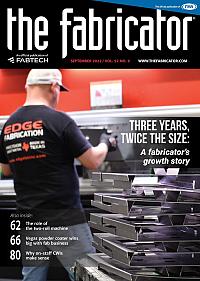Customer Experience Manager
- FMA
- The Fabricator
- FABTECH
- Canadian Metalworking
Categories
- Additive Manufacturing
- Aluminum Welding
- Arc Welding
- Assembly and Joining
- Automation and Robotics
- Bending and Forming
- Consumables
- Cutting and Weld Prep
- Electric Vehicles
- En Español
- Finishing
- Hydroforming
- Laser Cutting
- Laser Welding
- Machining
- Manufacturing Software
- Materials Handling
- Metals/Materials
- Oxyfuel Cutting
- Plasma Cutting
- Power Tools
- Punching and Other Holemaking
- Roll Forming
- Safety
- Sawing
- Shearing
- Shop Management
- Testing and Measuring
- Tube and Pipe Fabrication
- Tube and Pipe Production
- Waterjet Cutting
Industry Directory
Webcasts
Podcasts
FAB 40
Advertise
Subscribe
Account Login
Search
Getting a handle on production capacity through planning and scheduling
A proper tool helps metal fabricatio nshop floor managers make efficient, informed decisions
- By Brianna Merrill
- September 26, 2022
- Article
- Manufacturing Software

An advanced planning and scheduling tool can help to tame the chaos on a job shop’s floor and give owners and managers a true idea of what is happening in their manufacturing operations. Traitov/iStock/Getty Images Plus
For decades, fabricators have responded to the need to increase capacity by purchasing new machines and hiring more people—without accurately understanding their capacity. With an already fragile supply chain and the continued challenges of the COVID-19 pandemic, manufacturers must be able to react quickly and intelligently to unexpected changes to optimize production. Planning and scheduling are at the core of this optimization, helping manufacturers make informed decisions and become more efficient.
Manual Tools and ERP
A manufacturer’s day-to-day operations revolve around what is being produced, when it’s being produced, how it’s being produced, and what will be produced next.
It takes an enormous amount of time and energy to keep a manufacturing schedule up to date because of the inevitability of changing priorities and real-world constraints that all manufacturers face. Shop floor managers spend hours each day manually manipulating the schedule on paper or in a spreadsheet program to account for the barrage of changes. Not only are these manual methods inefficient, time-consuming, and costly ways to handle the downstream effects of constraints and changes on the shop floor, they also keep the operations manager from focusing on mission-critical tasks necessary for growth and success.
As an alternative, many manufacturers have tried enterprise resource planning (ERP) systems as all-encompassing tools to run operations. While these are great tools for creating sales orders, storing data, and sharing information, they don’t take into account the complexity and detail needed for planning and scheduling manufacturing operations. ERP software has limited ability to estimate production run start and end times. They create production orders at a high level and are not designed to create one-piece production orders. And they have limited functionality to capture the details of actuals, whether that’s the percentage of work completed in one shift or the number of labor hours spent on a customer order.
Over the years, ERP software developers reached out to varying vendors in an attempt to add more functionality geared towards planning and scheduling. Unfortunately, their attempts have been ignored by many because of the complexity and constraints within the manufacturing world. As manufacturers were let down by previous software implementations, they developed a negative mindset towards technology. Instead of spending more capital and time on investigating and finding another tool, manufacturers have leaned on paper and Excel as the means of running production.
Where, specifically, did ERP software fall short as it relates to planning and scheduling?
- Capacity planning and resource optimization - ERP software has limited ability to accurately estimate the start and end time in detail to provide a plan for the production floor to follow correctly.
- What-if analysis - ERP software provides an opportunity to enter the customer priorities and offers minimal insight to operations on the changes the sales team is dealing with, but has limited capability to do something about it and offer quick responses.
- Plan versus actuals - ERP software has limited functionality to capture details of the actuals, whether that be the percentage of work that was completed in one shift or how many actual labor hours were spent on a particular customer order.
- Simulation and digital twin - There is a need to understand the impact on the entire production system, and ERP software makes it difficult to simulate outcomes based on changes in master data.
- Trace and genealogy - ERP software creates production orders at a high-level and are not designed to create one-piece production orders.
In short, ERP software is not designed for manufacturers when it comes to finite capacity planning and operations scheduling.
Deciding How to Increase Capacity
Traditional thinking to increase capacity has been to purchase more equipment and add more labor resources to handle the increase in workload. While shop floor equipment and labor resources are vital to an operation’s existence, it also is necessary to understand both of their capacities.
Let’s say you have an opportunity to take on a new project and you need to decide whether to free-up equipment and push back an existing job, add a shift, or pay overtime to ensure on-time delivery. To make the right decision, you need accurate capacity data about your equipment and labor resources. That won’t be easy using inaccurate spreadsheets that have been manually manipulated over and over again. A planning and scheduling tool with what-if scenario capabilities, however, will let you know in seconds if you can take on the new project.
A what-if scenario allows manufacturers to plug-and-play with the schedule and available resources in a finite capacity to see how the changes impact operations. Having real-time data and an overview of the shop floor is vital to understanding capacity to make informed decisions. With such a tool, manufacturers are armed with data to run operations in a more efficient way for better use of their production capacity, and that allows them to take on more orders and thus increase production with what they have rather than spending more money on a new piece of equipment or hiring more labor.
Continuing, Unpredictable Challenges
The COVID-19 pandemic exposed and exacerbated manufacturing’s biggest weaknesses. The manufacturers that weathered the pandemic have continued to face supply chain disruptions, labor shortages, and record-high inflation, and these challenges don’t seem to be letting up any time soon.
Taking control and optimizing the core of manufacturing operations may seem like a daunting, investment-heavy burden, but it takes more time, money, and resources to fight the daily “fires” with no real progress. Manufacturers armed with data can make better decisions about how to adjust and restructure to accommodate and overcome these obstacles.
Taking Control of Operations
Harrison Mfg., an Indiana-based aerospace fabrication shop, was facing these same challenges and struggling with poor production performance, late deliveries, and costly overtime.
“I couldn’t find product on the floor; customers were calling to complain and demand updates on their orders, and I didn’t have answers for them,” said Ron Harrison, owner. “Our shop was putting out fires every day, with knee-jerk reactions to try to solve capacity issues, and it was nothing more than a guesstimate, taking actions like adding another shift to make up for time lost. I needed to understand our capacity to improve and take back control of our operation and costs.” Harrison Mfg. relied on white boards and spreadsheets prior to using production scheduling software.
“Once we identified where our biggest pain points were, we started researching solutions to close the gap. We had no idea there was a product out there that would not only fulfill these immediate pain points, but also automate so much more in our shop than we ever anticipated,” Harrison said.
Such a finite-capacity planning and scheduling tool is designed specifically for manufacturing operations, with flexibility to handle ever-changing constraints, priorities, and challenges. It takes into consideration a company’s limits on different resources and offers dynamic schedule updates based on actual shop floor progress. The system can create templates for operations in seconds, and users can edit the plan on-the-fly to see results. Paper and spreadsheets are eliminated. With real-time data tied to their operations, manufacturers can make quick, informed decisions to tackle supply chain disruptions and labor shortages when they are happening.
After implementing the system, Harrison Mfg.’s production times improved immediately because of order sequencing.
“We found capacity because it manages all your resources, allowing you to maximize your equipment and people,” Harrison said. “By automating these functions and looking at our operation holistically, we understand impacts of taking on new work and issues with the supply chain and labor shortages. We can be proactive to meet the demand and communicate with our customers, and that has been a game changer for us.”
The system’s what-if scenarios gave the company insight into how any type of change would impact business in the coming days, months, and years.
“We have cancelled the additional shift, realizing by automating our planning and scheduling that we’re able to do more work without adding capital expenditures and more people,” Harrison said. “We were able to run all production on just one shift and gained almost 20% more production.”
For many years, planning and scheduling have taken a backseat as a priority for improvement. Taking control of the core of their operations to optimize production can help manufacturers thrive in today’s uncertain and rapidly changing business climate.
About the Author
Brianna Merrill
530 Farrington St.
Terre Haute, IN 47807
subscribe now

The Fabricator is North America's leading magazine for the metal forming and fabricating industry. The magazine delivers the news, technical articles, and case histories that enable fabricators to do their jobs more efficiently. The Fabricator has served the industry since 1970.
start your free subscription- Stay connected from anywhere

Easily access valuable industry resources now with full access to the digital edition of The Fabricator.

Easily access valuable industry resources now with full access to the digital edition of The Welder.

Easily access valuable industry resources now with full access to the digital edition of The Tube and Pipe Journal.
- Podcasting
- Podcast:
- The Fabricator Podcast
- Published:
- 04/30/2024
- Running Time:
- 53:00
Seth Feldman of Iowa-based Wertzbaugher Services joins The Fabricator Podcast to offer his take as a Gen Zer...
- Trending Articles
JM Steel triples capacity for solar energy projects at Pennsylvania facility

Fabricating favorite childhood memories

How laser and TIG welding coexist in the modern job shop

Robotic welding sets up small-batch manufacturer for future growth

Ultra Tool and Manufacturing adds 2D laser system

- Industry Events
Pipe and Tube Conference
- May 21 - 22, 2024
- Omaha, NE
World-Class Roll Forming Workshop
- June 5 - 6, 2024
- Louisville, KY
Advanced Laser Application Workshop
- June 25 - 27, 2024
- Novi, MI
Precision Press Brake Certificate Course
- July 31 - August 1, 2024
- Elgin,


























